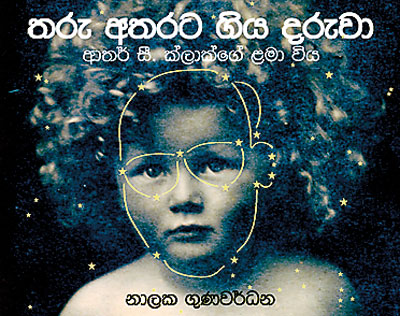Big lessons from young life of Arthur C. Clarke
View(s):While reading Nalaka Gunawardene’s latest Sinhala book, Tharu Atharata Giya Daruwa, on the childhood of Sir Arthur C. Clarke (1917-2008), I wanted to highlight the many lessons that can be learnt from the late author’s early life. I then discovered that Nalaka himself has done so in the final chapter.
In writing this well-researched and widely-illustrated book, Nalaka has opened a treasure trove to the Sinhala reader. Reading it reminded me of a remark by another shaper of our modern world, Steve Jobs. During his acclaimed speech at Stanford University, he said that in our lives, we can’t connect the dots looking forward; we can only do so looking backwards.
The life story of young Arthur Clarke is another example of this. Looking back, we can now trace events and factors that shaped the character of this extraordinary visionary, thinker and futurist.
Written in a simple language with appropriate historical context, the book highlights the key influences during Clarke’s first 20 years. Although the world today is very different from what existed in the 1920s and 1930s, the life lessons are universal and still relevant.
Born to an ordinary family in rural England as World War One was ending, young Arthur did not have a privileged life as a child. Yet he never allowed that to get in the way of pursuing his passions or dreams. He firmly had his eyes on the stars…
Nalaka recounts how seven-year-old Arthur’s interest in science and prehistory were sparked off by seeing dinosaur pictures given free with his father’s cigarette packs (ironic, since Clarke later firmly opposed tobacco). Enthused, he read everything he could find on dinosaurs, and went looking for fossils in his neighbourhood.
He also came up with fantastic tales with which he entertained his classmates and teachers. That was the beginning of one of the greatest science fiction writers of the 20th century!
In particular, Nalaka traces the decisive role his mother (Nora Willis Clarke, widowed at a young age) and some caring teachers played in moulding this talented and imaginative youngster.
Nora always encouraged her four kids to do the right thing – for example, sharing among siblings, caring for the less privileged and animals, being thrifty with money and carefully managing time. By involving her kids in household chores and farm work, Nora built self esteem and self reliance in them. In contrast, many parents of today are simply worried about children’s exam results.
While running the family farm and a guest house at home, Nora still found time to get involved in her children’s studies. For example, she played maths games that sharpened the Clarke family’s arithmetic skills. She also allowed Arthur to conduct his various experiments such as building small rockets and improvising on telephone systems — as long as he did those in his spare time and without risking life and limb.
Arthur’s well known love for domestic and wild animals stemmed from his childhood years spent caring for farm animals. One of his earliest baby photos shows him playing with puppies. On one occasion, he asked his mother not to sell a particular sheep that he had befriended. Decades later at his Colombo home, he used to place a personalized tombstone for each of his departed pets (several dogs and a monkey).
Bright and considerate as he was, Arthur had a mischievous side as well. Nalaka devotes several chapters to the childhood exploits and adventures of young Arthur. For example, we read about how he found ways to avoid cross-country running mandatory in school (because farm work gave him all the exercise he needed); how he used the laws of physics to design an ‘early warning system’ to know when the headmaster was approaching their classroom; how he rode a fire engine when village firemen were on a service call; and how he crashed into a circus elephant while cycling at night.
Nalaka also traces the key books and magazines that had a lasting influence on young Arthur, who readboth classical novels as well as pop culture products like cheap, illustrated story magazines (‘pulps’) coming from the United States.
But Arthur was no bookworm! In fact, he was very much into experimenting with whatever gadgets and tools accessible at the time (they had no electricity until he was 15). Fascinated by the night sky but unable to afford a telescope, he built his own at home. Discarded telecom and electronic items passed on by kind relatives were always put to good use. Enterprising Arthur even assembled radio sets and sold them to his friends at a small profit.
Shortly after he settled down in Ceylon in 1956, he met a kindred spirit in the accomplished Lankan inventor Ray Wijewardene, and a decades-long friendship ensued. Nalaka, who knew and worked with them both, offers personal insights on the wonderful collaboration between these two geniuses. He describes them as ‘forever young, inquisitive and imaginative’.
The 120-page book is enriched by several dozen photos, many drawn from the family archives, made available by the Arthur C Clarke Trust that now manages the Clarke Literary Estate. Artist Dharshana Karunathilake, who designed the book, has done a beautiful cover showing the face of young Arthur superimposed with a constellation of stars. He has also drawn some clever cartoons.
Overall, this delightful book can be highly recommended for readers of all ages and all walks of life. Its lessons for parents and teachers are especially important and relevant, to help them recognize early signs of children’s true talent and provide positive support.
[Deepal Sooriyaarachchi is a Chartered Marketer and Management Development Consultant. He is currently the Commissioner of the Sri Lanka Inventors Commission.]
| Book facts
Tharu Atharata Giya Daruwa: Childhood of Arthur C Clarke, by Nalaka Gunawardene. (Suratha Publishers). |


